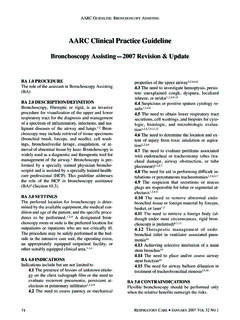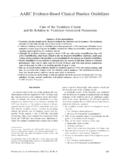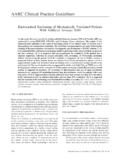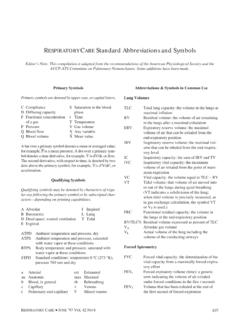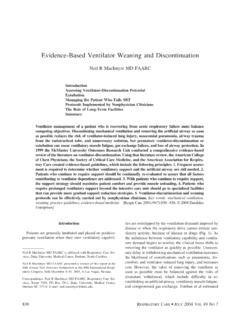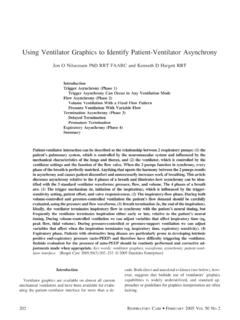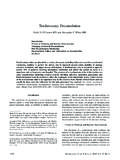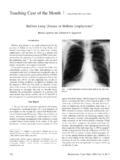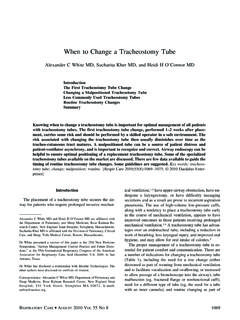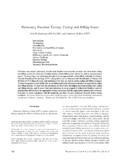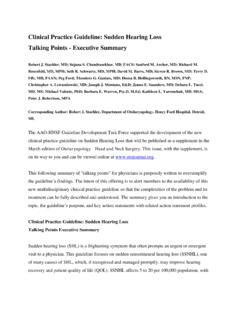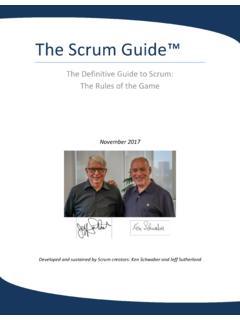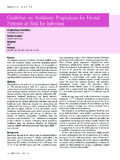Transcription of AARC Clinical Practice Guideline
1 AARC Guideline : OXYGENTHERAPY FORADULTS IN THEACUTECAREFACILITY717 RESPIRATORYCARE JUNE2002 VOL47 NO6OT-AC PROCEDURE:The procedure addressed is the administration ofoxygen therapy in the acute care facility other thanwith mechanical ventilators and hyperbaric DEFINITION/DESCRIPTION:Oxygen therapy is the administration of oxygen atconcentrations greater than that in ambient air withthe intent of treating or preventing the symptomsand manifestations of SETTING:This Guideline is confined to oxygen administra-tion in the acute care hypoxemia.
2 Defined as a de-creased PaO2in the blood below normal < 60 torr or SaO2of < 90% in subjectsbreathing room air or with PaO2and/or SaO2below desirable range for specific Clinical acute care situation in which hypoxemiais suspected1,3-6substantiation of hypoxemia isrequired within an appropriate period of time fol-lowing initiation of trauma5, myocardial infarction1, therapy or surgical intervention(eg, post-anesthesia recovery5,8, hip surgery9,10)OT-AC CONTRAINDICATIONS:No specific contraindications to oxygen therapyexist when indications are judged to be PRECAUTIONS AND/OR POSSI-BLE PaO2 60 torr, ventilatory depressionmay occur in spontaneously breathing patientswith elevated , FIO2 , absorption atelectasis, oxy-gen toxicity, and/or depression of ciliary and/orleukocytic function may ,15, Supplemental oxygen should be adminis-tered with caution to patients suffering fromparaquat poisoning17and to patients laser bronchoscopy.
3 Minimal levelsof supplemental oxygen should be used toavoid intratracheal hazard is increased in the presence ofincreased oxygen contamination associated withcertain nebulization and humidification sys-tems is a possible LIMITATIONS OF PROCEDURE:Oxygen therapy has only limited benefit for thetreatment of hypoxia due to anemia, and benefitmay be limited with circulatory disturbances. Oxy-gen therapy should not be used in lieu of but in ad-dition to mechanical ventilation when ventilatorysupport is ASSESSMENT OF NEED:Need is determined by measurement of inadequateoxygen tensions and/or saturations, by invasive ornoninvasive methods, and/or the presence of clini-cal indicators as previously ASSESSMENT OF OUTCOME:Outcome is determined by Clinical and physiologicassessment to establish adequacy of patient re-sponse to RESOURCES.
4 For other types of oxygen delivery devices usedoutside of the acute care facility, reference theAARC Clinical Practice Guideline : Oxygen Thera-py in the Home or Extended Care Facility for fur-ther description. Respir Care 1992;37(8) Clinical Practice GuidelineOxygen Therapy for Adults in the Acute Care Facility 2002 Revision & UpdateAARC Guideline : OXYGENTHERAPY FORADULTS IN THEACUTECAREFACILITY718 RESPIRATORYCARE JUNE2002 VOL47 systems deliver 100%(ie, FDO2= ) oxygen at flows that areless than the patient s inspiratory flowrate(ie, the delivered oxygen is diluted withroom air) and, thus, the oxygen concentra-tion inhaled (FIO2) may be low or high,depending on the specific device and thepatient s inspiratory , cannulas can provide24-40% oxygen with flowrates up to 6L/min in adults (depending on ventila-tory pattern).
5 1 Oxygen supplied vianasal cannula at flowrates 4 L/minneed not be ,26 Care mustbe taken when assigning an estimatedFIO2to patients as this low-flow systemcan have great oxygen masks can pro-vide 35-50% FIO2, depending on fit, atflowrates from 5-10 L/min. Flowratesshould be maintained at 5 L/min ormore in order to avoid rebreathing ex-haled CO2that can be retained in ,20,28 Caution should be takenwhen using a simple mask where accu-rate delivery of low concentrations ofoxygen is use ofsimple mask can lead to skin irritationand pressure rebreathing mask is asimple mask with a reservoir bag.
6 Oxy-gen flow should always be supplied tomaintain the reservior bag at least onethird to one half full on inspiration. Ata flow of 6-10 L/min the system canprovide 40-70% oxygen. It is consid-ered a low-flow system. The non-re-breathing mask is similar to the partialrebreathing mask except it has a seriesof one-way valves. One valve is placedbetween the bag and the mask to pre-vent exhaled air from returning to thebag. There should be a minimum flowof 10 L/min. The delivered FIO2of thissystem is 60-80%. who have been re-ceiving transtracheal oxygen at homemay continue to receive oxygen by thismethod in the acute care facility settingprovided no problems present.
7 If diffi-culties related to the transtracheal routeof administration appear, oxygenationshould be assured by other systems deliver a pre-scribed gas mixture either high or lowFDO2at flowrates that exceed patient ,24, available air-en-trainment masks can accurately deliverpredetermined oxygen concentration tothe trachea up to 40%. Jet-mixingmasks rated at 35% or higher usuallydo not deliver flowrates adequate tomeet the inspiratory flowrates of adultsin respiratory ,24,31, masks, tracheostomycollars, T-tube adapters, and face tentscan be used with high-flow supplemen-tal oxygen systems.
8 A continuousaerosol generator or large-volumereservoir humidifier can humidify thegas flow. Some aerosol generators can-not provide adequate flows at highoxygen Level Ipersonnel ie, any personwho has adequately demonstrated theability to perform the task may checkand document that a device is being usedappropriately and the flow is as Level IIpersonnel licensed orcredentialed respiratory care practitionersor persons with equivalent training anddocumented ability to perform the tasks may assess patients, initiate and monitoroxygen delivery systems.
9 And recommendchanges in assessment including butnot limited to cardiac, pulmonary, andneurologic of physiologic parame-ters: measurement of PaO2s or saturationin any patient treated with oxygen. An ap-propriate oxygen therapy utilization pro-tocol is suggested as a method to decreaseAARC Guideline : OXYGENTHERAPY FORADULTS IN THEACUTECAREFACILITY719 RESPIRATORYCARE JUNE2002 VOL47 NO6waste and to realize increased cost need/indication to adjustFDO2for increased levels of activity conjunction with the initia-tion of therapy.
10 12 hours of initiationwith FIO2< 8 hours, with FIO2 (including postanesthesia recov-ery) 72 hours in acute my-ocardial 2 hours for any patientwith the principal diagnosis of oxygen delivery systemsshould be checked at least once per frequent checks by calibratedanalyzer are necessary in to variation in oxy-gen concentration (eg, high-flowblending systems) to patients with artifi-cial a heated gas to patients who areclinically unstable or who require anFIO2of or should be taken to avoid inter-ruption of oxygen therapy in situations in-cluding ambulation or transport for FREQUENCY:Oxygen therapy should be administered continu-ously unless the need has been shown to be associ-ated only with specific situations (eg, exercise andsleep).
